Managing Small and Medium Enterprises: icar Rentals Growth Report
VerifiedAdded on 2021/05/31
|22
|6821
|296
Report
AI Summary
This report provides a comprehensive evaluation of icar Rentals, a Small to Medium Enterprise (SME) operating in West London, assessing its growth and development within the competitive vehicle rental market. The report examines the entrepreneur's background, the SME's start-up process, business concept, and sources of competitive advantage. It analyzes the current market demand, competitive environment, and the company's growth strategies, including its adaptation to online booking and its commitment to environmental responsibility. The report also highlights the challenges faced by the business and explores governmental support options. Based on theoretical frameworks and market analysis, the report offers recommendations for targeting key consumer groups and sustaining future growth, incorporating both quantitative and qualitative data from interviews, financial statements, and industry data to present a well-rounded assessment of icar Rentals' performance and potential.
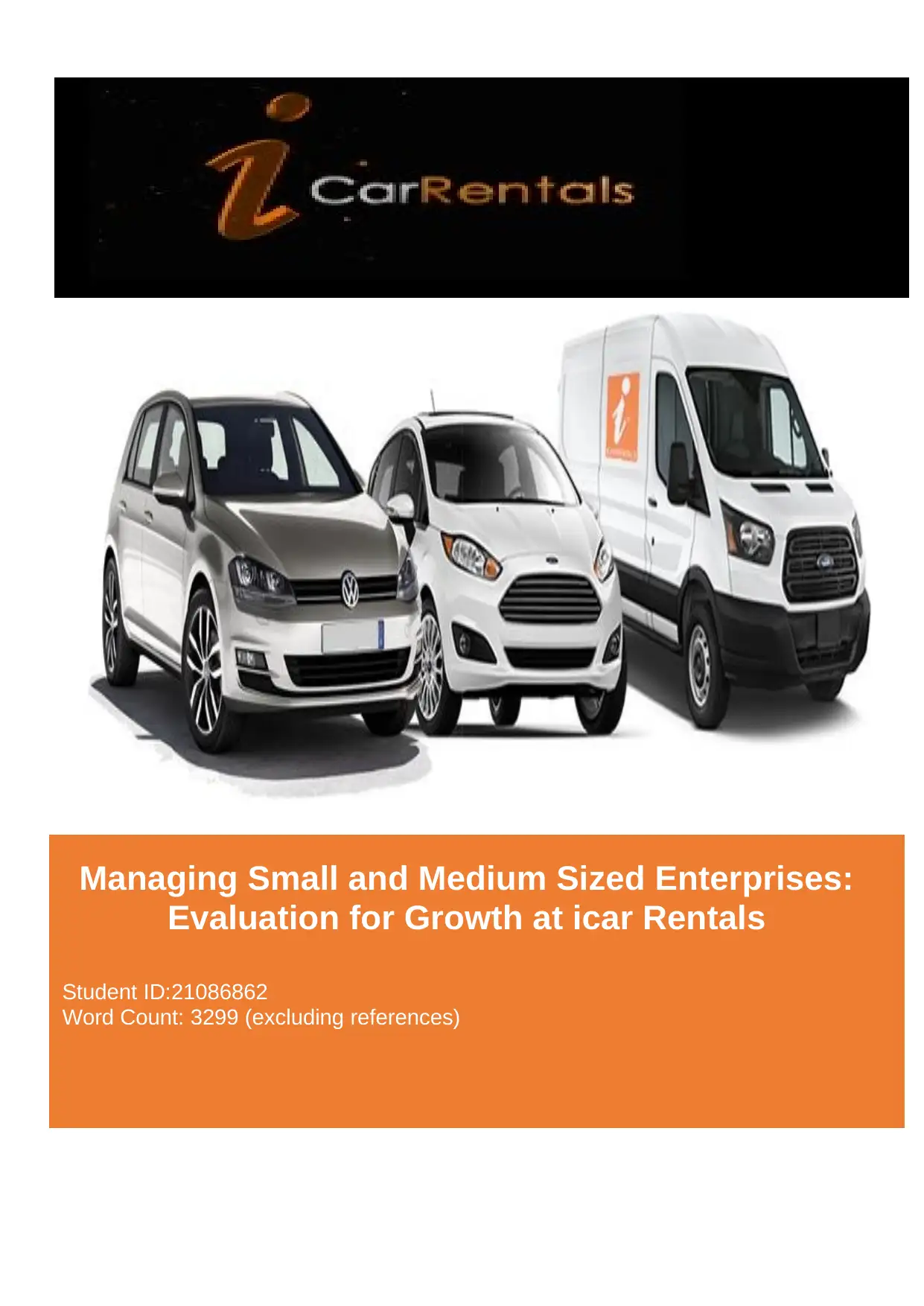
Managing Small and Medium Sized Enterprises:
Evaluation for Growth at icar Rentals
Student ID:21086862
Word Count: 3299 (excluding references)
Evaluation for Growth at icar Rentals
Student ID:21086862
Word Count: 3299 (excluding references)
Paraphrase This Document
Need a fresh take? Get an instant paraphrase of this document with our AI Paraphraser
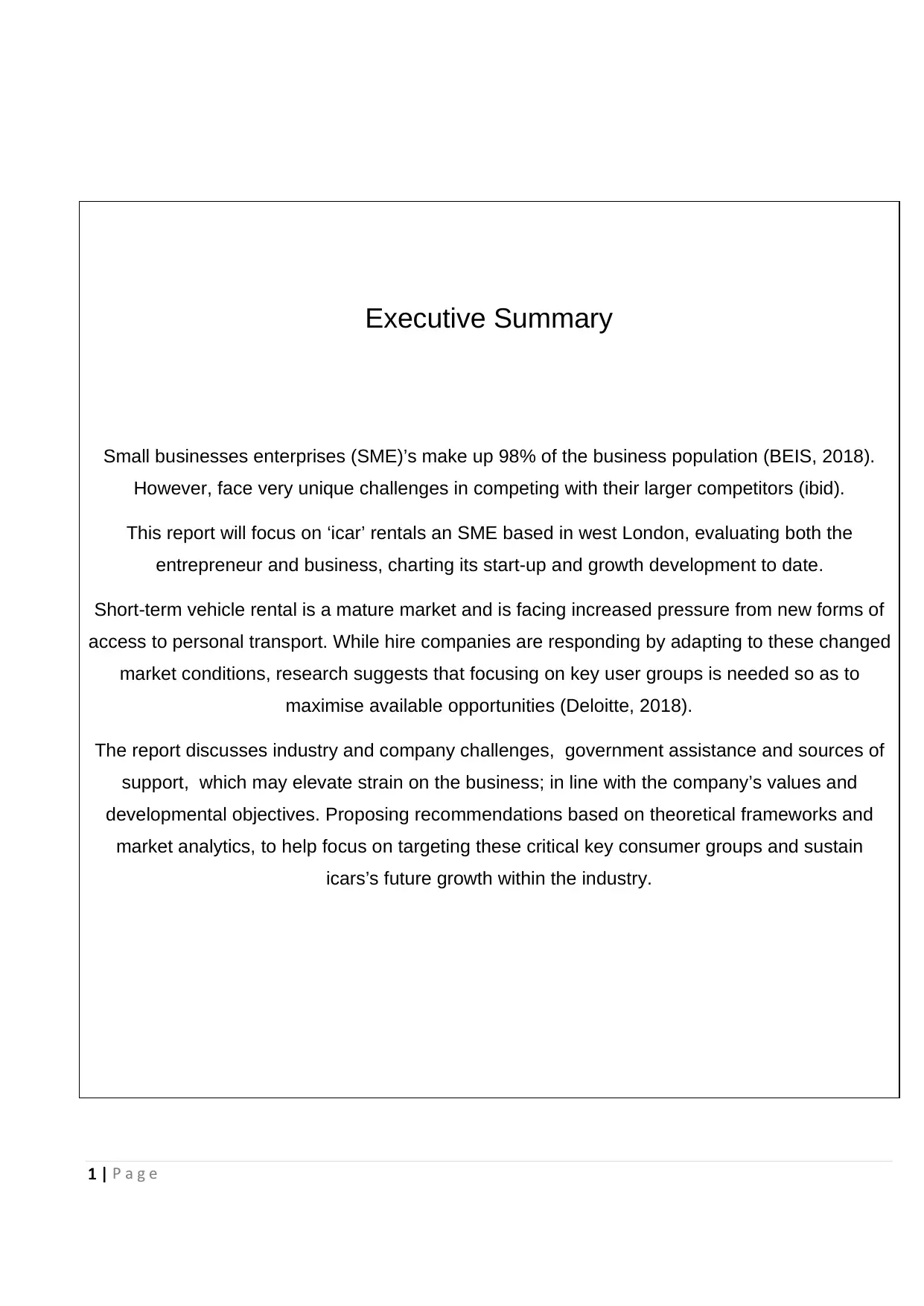
1 | P a g e
Executive Summary
Small businesses enterprises (SME)’s make up 98% of the business population (BEIS, 2018).
However, face very unique challenges in competing with their larger competitors (ibid).
This report will focus on ‘icar’ rentals an SME based in west London, evaluating both the
entrepreneur and business, charting its start-up and growth development to date.
Short-term vehicle rental is a mature market and is facing increased pressure from new forms of
access to personal transport. While hire companies are responding by adapting to these changed
market conditions, research suggests that focusing on key user groups is needed so as to
maximise available opportunities (Deloitte, 2018).
The report discusses industry and company challenges, government assistance and sources of
support, which may elevate strain on the business; in line with the company’s values and
developmental objectives. Proposing recommendations based on theoretical frameworks and
market analytics, to help focus on targeting these critical key consumer groups and sustain
icars’s future growth within the industry.
Executive Summary
Small businesses enterprises (SME)’s make up 98% of the business population (BEIS, 2018).
However, face very unique challenges in competing with their larger competitors (ibid).
This report will focus on ‘icar’ rentals an SME based in west London, evaluating both the
entrepreneur and business, charting its start-up and growth development to date.
Short-term vehicle rental is a mature market and is facing increased pressure from new forms of
access to personal transport. While hire companies are responding by adapting to these changed
market conditions, research suggests that focusing on key user groups is needed so as to
maximise available opportunities (Deloitte, 2018).
The report discusses industry and company challenges, government assistance and sources of
support, which may elevate strain on the business; in line with the company’s values and
developmental objectives. Proposing recommendations based on theoretical frameworks and
market analytics, to help focus on targeting these critical key consumer groups and sustain
icars’s future growth within the industry.
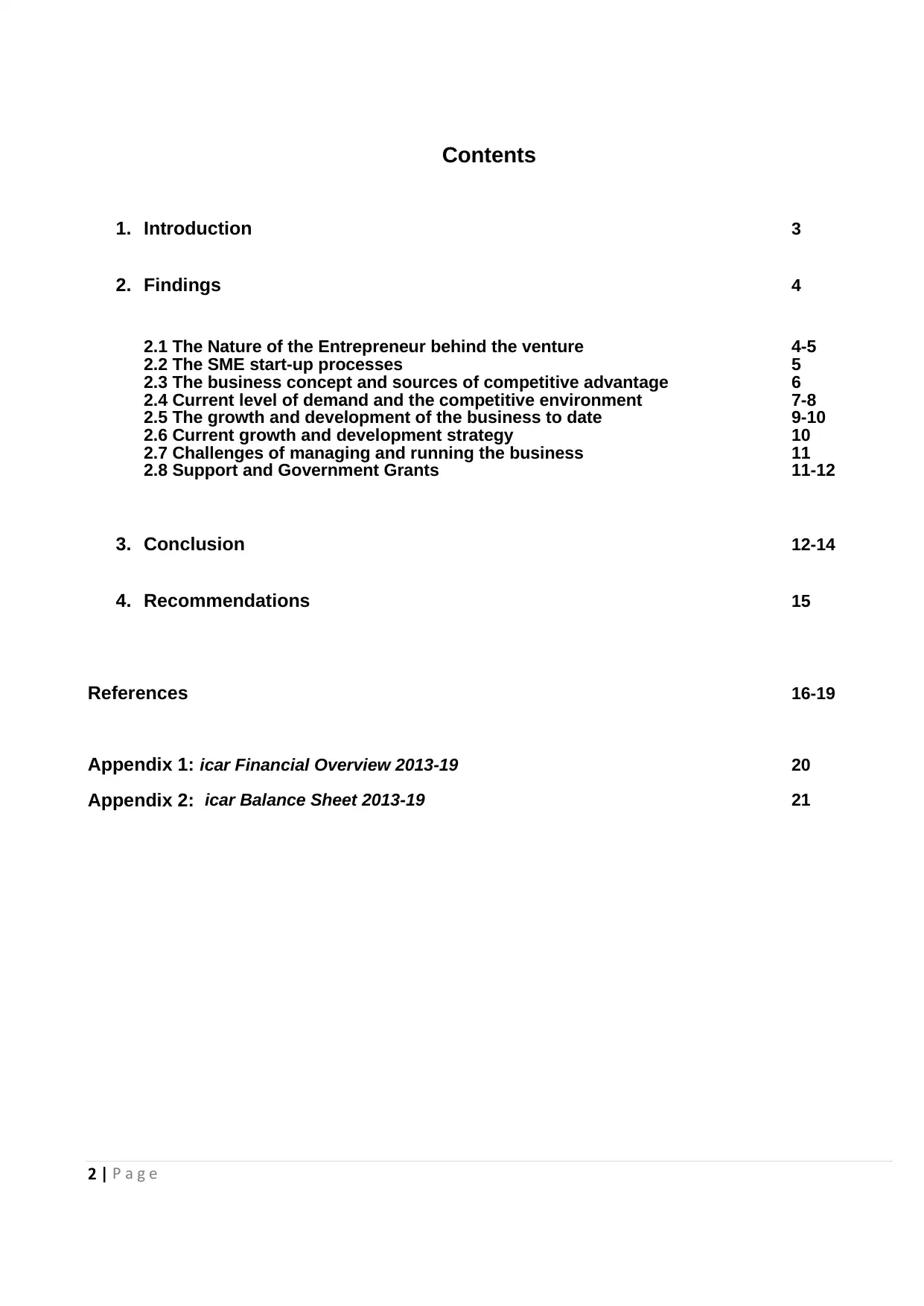
2 | P a g e
Contents
1. Introduction 3
2. Findings 4
2.1 The Nature of the Entrepreneur behind the venture 4-5
2.2 The SME start-up processes 5
2.3 The business concept and sources of competitive advantage 6
2.4 Current level of demand and the competitive environment 7-8
2.5 The growth and development of the business to date 9-10
2.6 Current growth and development strategy 10
2.7 Challenges of managing and running the business 11
2.8 Support and Government Grants 11-12
3. Conclusion 12-14
4. Recommendations 15
References 16-19
Appendix 1: icar Financial Overview 2013-19 20
Appendix 2: icar Balance Sheet 2013-19 21
Contents
1. Introduction 3
2. Findings 4
2.1 The Nature of the Entrepreneur behind the venture 4-5
2.2 The SME start-up processes 5
2.3 The business concept and sources of competitive advantage 6
2.4 Current level of demand and the competitive environment 7-8
2.5 The growth and development of the business to date 9-10
2.6 Current growth and development strategy 10
2.7 Challenges of managing and running the business 11
2.8 Support and Government Grants 11-12
3. Conclusion 12-14
4. Recommendations 15
References 16-19
Appendix 1: icar Financial Overview 2013-19 20
Appendix 2: icar Balance Sheet 2013-19 21
⊘ This is a preview!⊘
Do you want full access?
Subscribe today to unlock all pages.

Trusted by 1+ million students worldwide
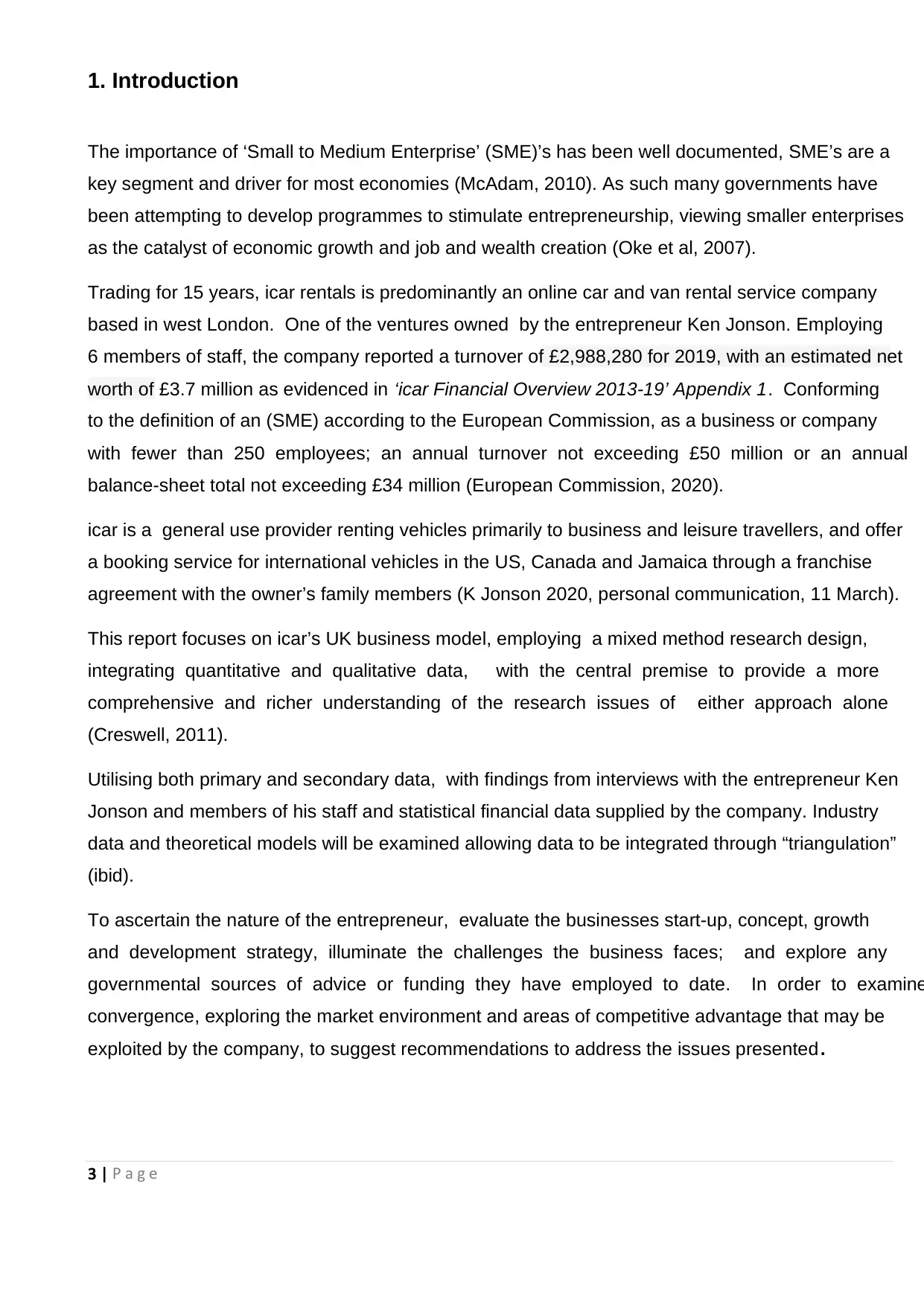
3 | P a g e
1. Introduction
The importance of ‘Small to Medium Enterprise’ (SME)’s has been well documented, SME’s are a
key segment and driver for most economies (McAdam, 2010). As such many governments have
been attempting to develop programmes to stimulate entrepreneurship, viewing smaller enterprises
as the catalyst of economic growth and job and wealth creation (Oke et al, 2007).
Trading for 15 years, icar rentals is predominantly an online car and van rental service company
based in west London. One of the ventures owned by the entrepreneur Ken Jonson. Employing
6 members of staff, the company reported a turnover of £2,988,280 for 2019, with an estimated net
worth of £3.7 million as evidenced in ‘icar Financial Overview 2013-19’ Appendix 1. Conforming
to the definition of an (SME) according to the European Commission, as a business or company
with fewer than 250 employees; an annual turnover not exceeding £50 million or an annual
balance-sheet total not exceeding £34 million (European Commission, 2020).
icar is a general use provider renting vehicles primarily to business and leisure travellers, and offer
a booking service for international vehicles in the US, Canada and Jamaica through a franchise
agreement with the owner’s family members (K Jonson 2020, personal communication, 11 March).
This report focuses on icar’s UK business model, employing a mixed method research design,
integrating quantitative and qualitative data, with the central premise to provide a more
comprehensive and richer understanding of the research issues of either approach alone
(Creswell, 2011).
Utilising both primary and secondary data, with findings from interviews with the entrepreneur Ken
Jonson and members of his staff and statistical financial data supplied by the company. Industry
data and theoretical models will be examined allowing data to be integrated through “triangulation”
(ibid).
To ascertain the nature of the entrepreneur, evaluate the businesses start-up, concept, growth
and development strategy, illuminate the challenges the business faces; and explore any
governmental sources of advice or funding they have employed to date. In order to examine
convergence, exploring the market environment and areas of competitive advantage that may be
exploited by the company, to suggest recommendations to address the issues presented.
1. Introduction
The importance of ‘Small to Medium Enterprise’ (SME)’s has been well documented, SME’s are a
key segment and driver for most economies (McAdam, 2010). As such many governments have
been attempting to develop programmes to stimulate entrepreneurship, viewing smaller enterprises
as the catalyst of economic growth and job and wealth creation (Oke et al, 2007).
Trading for 15 years, icar rentals is predominantly an online car and van rental service company
based in west London. One of the ventures owned by the entrepreneur Ken Jonson. Employing
6 members of staff, the company reported a turnover of £2,988,280 for 2019, with an estimated net
worth of £3.7 million as evidenced in ‘icar Financial Overview 2013-19’ Appendix 1. Conforming
to the definition of an (SME) according to the European Commission, as a business or company
with fewer than 250 employees; an annual turnover not exceeding £50 million or an annual
balance-sheet total not exceeding £34 million (European Commission, 2020).
icar is a general use provider renting vehicles primarily to business and leisure travellers, and offer
a booking service for international vehicles in the US, Canada and Jamaica through a franchise
agreement with the owner’s family members (K Jonson 2020, personal communication, 11 March).
This report focuses on icar’s UK business model, employing a mixed method research design,
integrating quantitative and qualitative data, with the central premise to provide a more
comprehensive and richer understanding of the research issues of either approach alone
(Creswell, 2011).
Utilising both primary and secondary data, with findings from interviews with the entrepreneur Ken
Jonson and members of his staff and statistical financial data supplied by the company. Industry
data and theoretical models will be examined allowing data to be integrated through “triangulation”
(ibid).
To ascertain the nature of the entrepreneur, evaluate the businesses start-up, concept, growth
and development strategy, illuminate the challenges the business faces; and explore any
governmental sources of advice or funding they have employed to date. In order to examine
convergence, exploring the market environment and areas of competitive advantage that may be
exploited by the company, to suggest recommendations to address the issues presented.
Paraphrase This Document
Need a fresh take? Get an instant paraphrase of this document with our AI Paraphraser
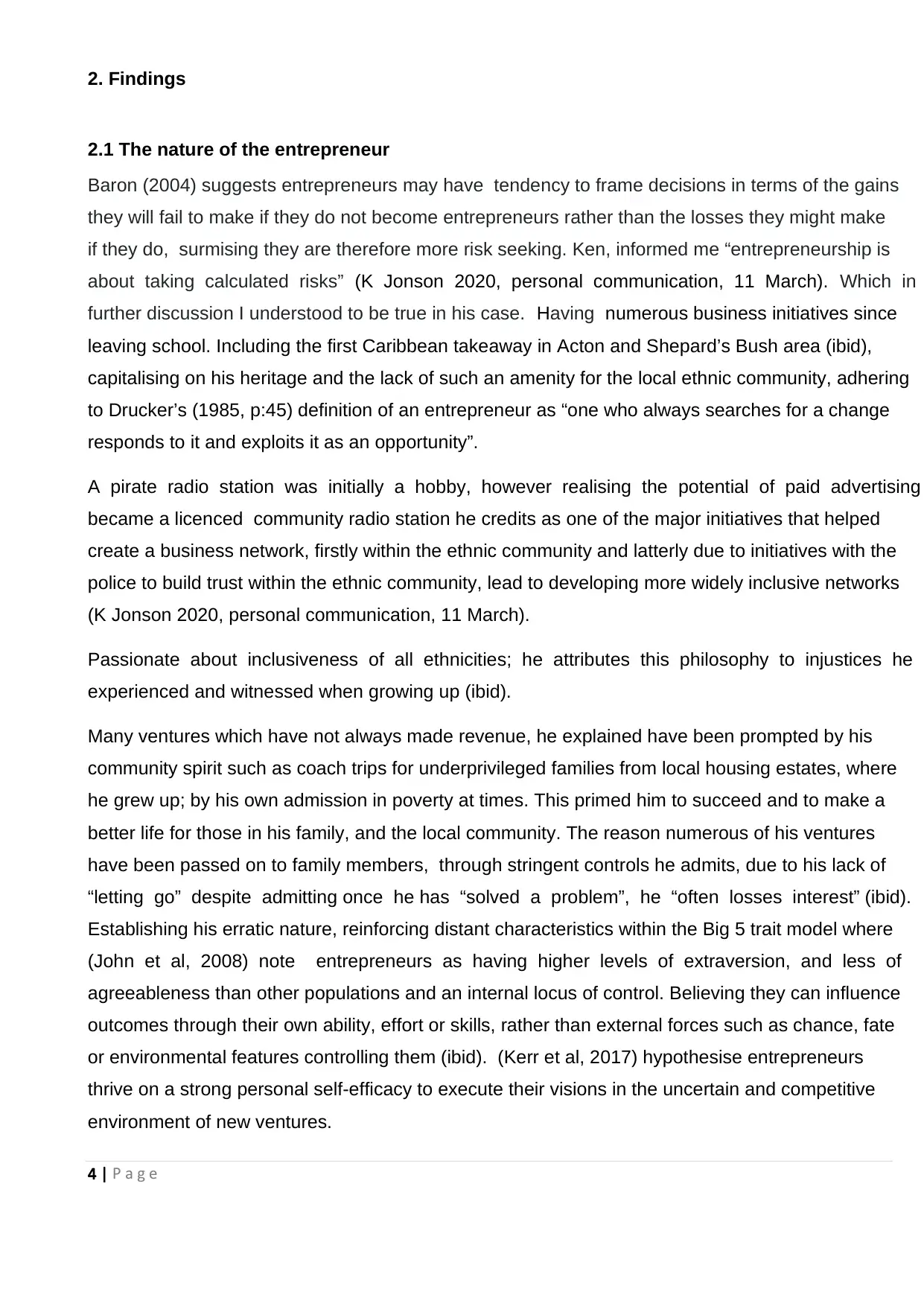
4 | P a g e
2. Findings
2.1 The nature of the entrepreneur
Baron (2004) suggests entrepreneurs may have tendency to frame decisions in terms of the gains
they will fail to make if they do not become entrepreneurs rather than the losses they might make
if they do, surmising they are therefore more risk seeking. Ken, informed me “entrepreneurship is
about taking calculated risks” (K Jonson 2020, personal communication, 11 March). Which in
further discussion I understood to be true in his case. Having numerous business initiatives since
leaving school. Including the first Caribbean takeaway in Acton and Shepard’s Bush area (ibid),
capitalising on his heritage and the lack of such an amenity for the local ethnic community, adhering
to Drucker’s (1985, p:45) definition of an entrepreneur as “one who always searches for a change
responds to it and exploits it as an opportunity”.
A pirate radio station was initially a hobby, however realising the potential of paid advertising
became a licenced community radio station he credits as one of the major initiatives that helped
create a business network, firstly within the ethnic community and latterly due to initiatives with the
police to build trust within the ethnic community, lead to developing more widely inclusive networks
(K Jonson 2020, personal communication, 11 March).
Passionate about inclusiveness of all ethnicities; he attributes this philosophy to injustices he
experienced and witnessed when growing up (ibid).
Many ventures which have not always made revenue, he explained have been prompted by his
community spirit such as coach trips for underprivileged families from local housing estates, where
he grew up; by his own admission in poverty at times. This primed him to succeed and to make a
better life for those in his family, and the local community. The reason numerous of his ventures
have been passed on to family members, through stringent controls he admits, due to his lack of
“letting go” despite admitting once he has “solved a problem”, he “often losses interest” (ibid).
Establishing his erratic nature, reinforcing distant characteristics within the Big 5 trait model where
(John et al, 2008) note entrepreneurs as having higher levels of extraversion, and less of
agreeableness than other populations and an internal locus of control. Believing they can influence
outcomes through their own ability, effort or skills, rather than external forces such as chance, fate
or environmental features controlling them (ibid). (Kerr et al, 2017) hypothesise entrepreneurs
thrive on a strong personal self-efficacy to execute their visions in the uncertain and competitive
environment of new ventures.
2. Findings
2.1 The nature of the entrepreneur
Baron (2004) suggests entrepreneurs may have tendency to frame decisions in terms of the gains
they will fail to make if they do not become entrepreneurs rather than the losses they might make
if they do, surmising they are therefore more risk seeking. Ken, informed me “entrepreneurship is
about taking calculated risks” (K Jonson 2020, personal communication, 11 March). Which in
further discussion I understood to be true in his case. Having numerous business initiatives since
leaving school. Including the first Caribbean takeaway in Acton and Shepard’s Bush area (ibid),
capitalising on his heritage and the lack of such an amenity for the local ethnic community, adhering
to Drucker’s (1985, p:45) definition of an entrepreneur as “one who always searches for a change
responds to it and exploits it as an opportunity”.
A pirate radio station was initially a hobby, however realising the potential of paid advertising
became a licenced community radio station he credits as one of the major initiatives that helped
create a business network, firstly within the ethnic community and latterly due to initiatives with the
police to build trust within the ethnic community, lead to developing more widely inclusive networks
(K Jonson 2020, personal communication, 11 March).
Passionate about inclusiveness of all ethnicities; he attributes this philosophy to injustices he
experienced and witnessed when growing up (ibid).
Many ventures which have not always made revenue, he explained have been prompted by his
community spirit such as coach trips for underprivileged families from local housing estates, where
he grew up; by his own admission in poverty at times. This primed him to succeed and to make a
better life for those in his family, and the local community. The reason numerous of his ventures
have been passed on to family members, through stringent controls he admits, due to his lack of
“letting go” despite admitting once he has “solved a problem”, he “often losses interest” (ibid).
Establishing his erratic nature, reinforcing distant characteristics within the Big 5 trait model where
(John et al, 2008) note entrepreneurs as having higher levels of extraversion, and less of
agreeableness than other populations and an internal locus of control. Believing they can influence
outcomes through their own ability, effort or skills, rather than external forces such as chance, fate
or environmental features controlling them (ibid). (Kerr et al, 2017) hypothesise entrepreneurs
thrive on a strong personal self-efficacy to execute their visions in the uncertain and competitive
environment of new ventures.
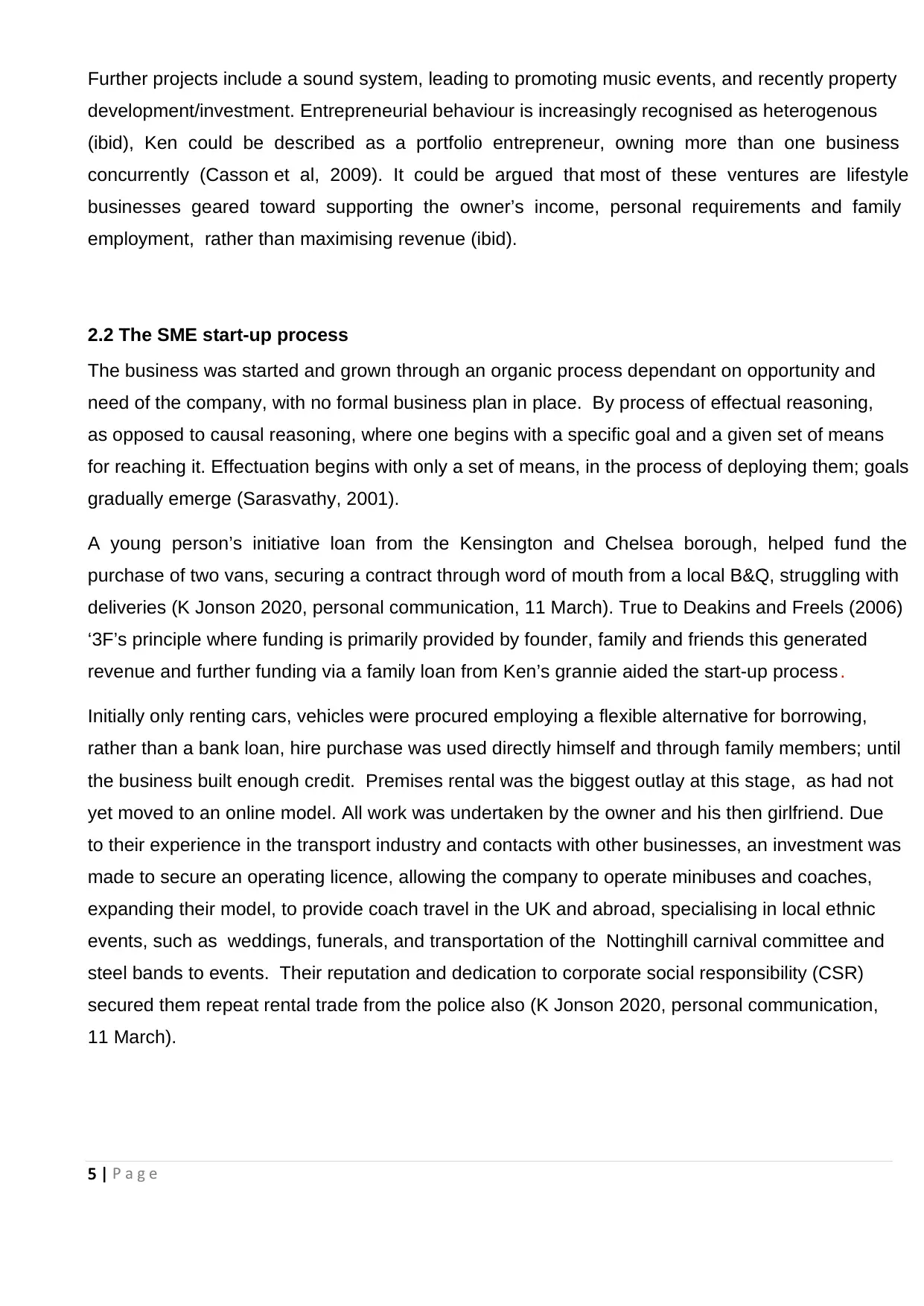
5 | P a g e
Further projects include a sound system, leading to promoting music events, and recently property
development/investment. Entrepreneurial behaviour is increasingly recognised as heterogenous
(ibid), Ken could be described as a portfolio entrepreneur, owning more than one business
concurrently (Casson et al, 2009). It could be argued that most of these ventures are lifestyle
businesses geared toward supporting the owner’s income, personal requirements and family
employment, rather than maximising revenue (ibid).
2.2 The SME start-up process
The business was started and grown through an organic process dependant on opportunity and
need of the company, with no formal business plan in place. By process of effectual reasoning,
as opposed to causal reasoning, where one begins with a specific goal and a given set of means
for reaching it. Effectuation begins with only a set of means, in the process of deploying them; goals
gradually emerge (Sarasvathy, 2001).
A young person’s initiative loan from the Kensington and Chelsea borough, helped fund the
purchase of two vans, securing a contract through word of mouth from a local B&Q, struggling with
deliveries (K Jonson 2020, personal communication, 11 March). True to Deakins and Freels (2006)
‘3F’s principle where funding is primarily provided by founder, family and friends this generated
revenue and further funding via a family loan from Ken’s grannie aided the start-up process .
Initially only renting cars, vehicles were procured employing a flexible alternative for borrowing,
rather than a bank loan, hire purchase was used directly himself and through family members; until
the business built enough credit. Premises rental was the biggest outlay at this stage, as had not
yet moved to an online model. All work was undertaken by the owner and his then girlfriend. Due
to their experience in the transport industry and contacts with other businesses, an investment was
made to secure an operating licence, allowing the company to operate minibuses and coaches,
expanding their model, to provide coach travel in the UK and abroad, specialising in local ethnic
events, such as weddings, funerals, and transportation of the Nottinghill carnival committee and
steel bands to events. Their reputation and dedication to corporate social responsibility (CSR)
secured them repeat rental trade from the police also (K Jonson 2020, personal communication,
11 March).
Further projects include a sound system, leading to promoting music events, and recently property
development/investment. Entrepreneurial behaviour is increasingly recognised as heterogenous
(ibid), Ken could be described as a portfolio entrepreneur, owning more than one business
concurrently (Casson et al, 2009). It could be argued that most of these ventures are lifestyle
businesses geared toward supporting the owner’s income, personal requirements and family
employment, rather than maximising revenue (ibid).
2.2 The SME start-up process
The business was started and grown through an organic process dependant on opportunity and
need of the company, with no formal business plan in place. By process of effectual reasoning,
as opposed to causal reasoning, where one begins with a specific goal and a given set of means
for reaching it. Effectuation begins with only a set of means, in the process of deploying them; goals
gradually emerge (Sarasvathy, 2001).
A young person’s initiative loan from the Kensington and Chelsea borough, helped fund the
purchase of two vans, securing a contract through word of mouth from a local B&Q, struggling with
deliveries (K Jonson 2020, personal communication, 11 March). True to Deakins and Freels (2006)
‘3F’s principle where funding is primarily provided by founder, family and friends this generated
revenue and further funding via a family loan from Ken’s grannie aided the start-up process .
Initially only renting cars, vehicles were procured employing a flexible alternative for borrowing,
rather than a bank loan, hire purchase was used directly himself and through family members; until
the business built enough credit. Premises rental was the biggest outlay at this stage, as had not
yet moved to an online model. All work was undertaken by the owner and his then girlfriend. Due
to their experience in the transport industry and contacts with other businesses, an investment was
made to secure an operating licence, allowing the company to operate minibuses and coaches,
expanding their model, to provide coach travel in the UK and abroad, specialising in local ethnic
events, such as weddings, funerals, and transportation of the Nottinghill carnival committee and
steel bands to events. Their reputation and dedication to corporate social responsibility (CSR)
secured them repeat rental trade from the police also (K Jonson 2020, personal communication,
11 March).
⊘ This is a preview!⊘
Do you want full access?
Subscribe today to unlock all pages.

Trusted by 1+ million students worldwide
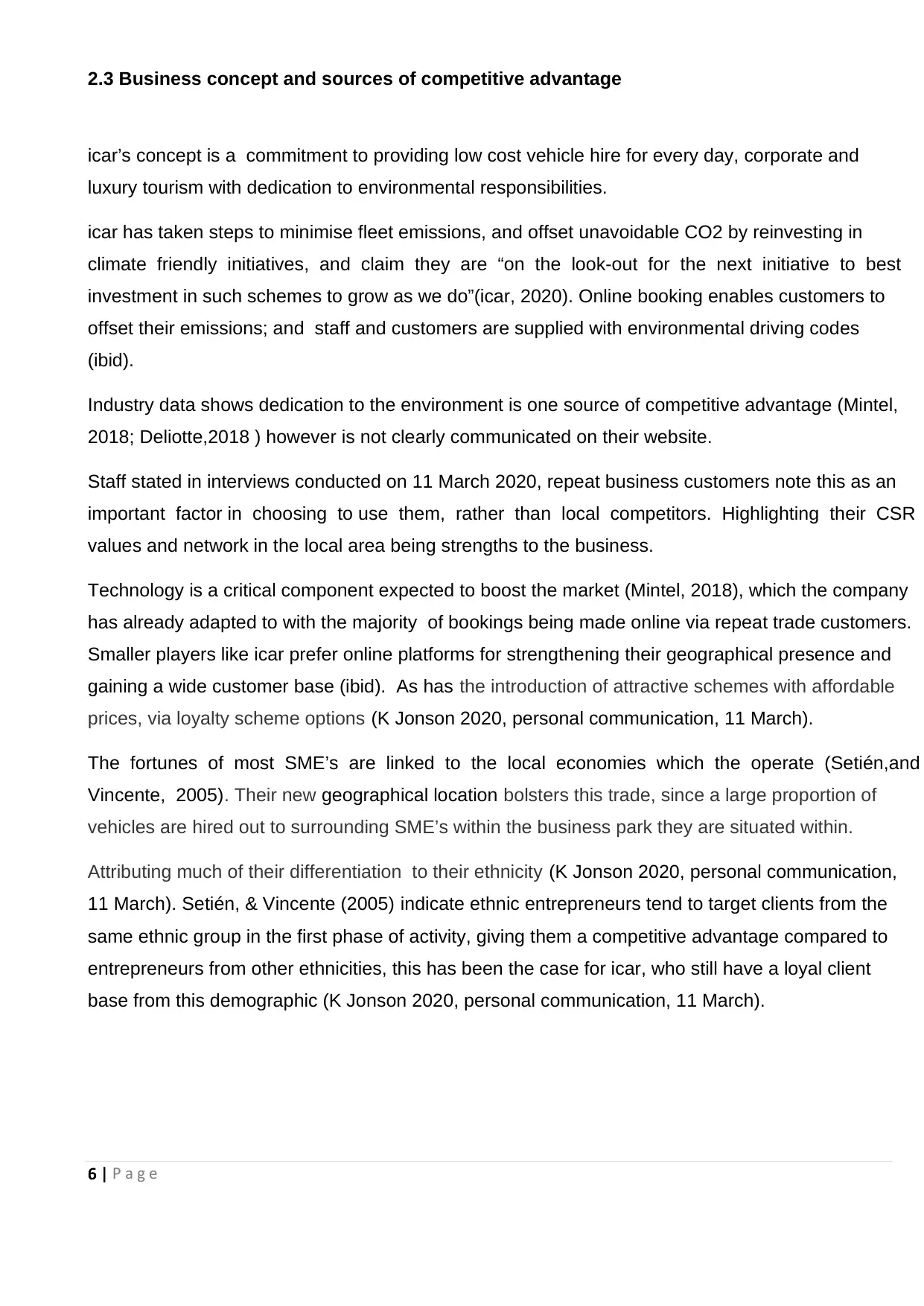
6 | P a g e
2.3 Business concept and sources of competitive advantage
icar’s concept is a commitment to providing low cost vehicle hire for every day, corporate and
luxury tourism with dedication to environmental responsibilities.
icar has taken steps to minimise fleet emissions, and offset unavoidable CO2 by reinvesting in
climate friendly initiatives, and claim they are “on the look-out for the next initiative to best
investment in such schemes to grow as we do”(icar, 2020). Online booking enables customers to
offset their emissions; and staff and customers are supplied with environmental driving codes
(ibid).
Industry data shows dedication to the environment is one source of competitive advantage (Mintel,
2018; Deliotte,2018 ) however is not clearly communicated on their website.
Staff stated in interviews conducted on 11 March 2020, repeat business customers note this as an
important factor in choosing to use them, rather than local competitors. Highlighting their CSR
values and network in the local area being strengths to the business.
Technology is a critical component expected to boost the market (Mintel, 2018), which the company
has already adapted to with the majority of bookings being made online via repeat trade customers.
Smaller players like icar prefer online platforms for strengthening their geographical presence and
gaining a wide customer base (ibid). As has the introduction of attractive schemes with affordable
prices, via loyalty scheme options (K Jonson 2020, personal communication, 11 March).
The fortunes of most SME’s are linked to the local economies which the operate (Setién,and
Vincente, 2005). Their new geographical location bolsters this trade, since a large proportion of
vehicles are hired out to surrounding SME’s within the business park they are situated within.
Attributing much of their differentiation to their ethnicity (K Jonson 2020, personal communication,
11 March). Setién, & Vincente (2005) indicate ethnic entrepreneurs tend to target clients from the
same ethnic group in the first phase of activity, giving them a competitive advantage compared to
entrepreneurs from other ethnicities, this has been the case for icar, who still have a loyal client
base from this demographic (K Jonson 2020, personal communication, 11 March).
2.3 Business concept and sources of competitive advantage
icar’s concept is a commitment to providing low cost vehicle hire for every day, corporate and
luxury tourism with dedication to environmental responsibilities.
icar has taken steps to minimise fleet emissions, and offset unavoidable CO2 by reinvesting in
climate friendly initiatives, and claim they are “on the look-out for the next initiative to best
investment in such schemes to grow as we do”(icar, 2020). Online booking enables customers to
offset their emissions; and staff and customers are supplied with environmental driving codes
(ibid).
Industry data shows dedication to the environment is one source of competitive advantage (Mintel,
2018; Deliotte,2018 ) however is not clearly communicated on their website.
Staff stated in interviews conducted on 11 March 2020, repeat business customers note this as an
important factor in choosing to use them, rather than local competitors. Highlighting their CSR
values and network in the local area being strengths to the business.
Technology is a critical component expected to boost the market (Mintel, 2018), which the company
has already adapted to with the majority of bookings being made online via repeat trade customers.
Smaller players like icar prefer online platforms for strengthening their geographical presence and
gaining a wide customer base (ibid). As has the introduction of attractive schemes with affordable
prices, via loyalty scheme options (K Jonson 2020, personal communication, 11 March).
The fortunes of most SME’s are linked to the local economies which the operate (Setién,and
Vincente, 2005). Their new geographical location bolsters this trade, since a large proportion of
vehicles are hired out to surrounding SME’s within the business park they are situated within.
Attributing much of their differentiation to their ethnicity (K Jonson 2020, personal communication,
11 March). Setién, & Vincente (2005) indicate ethnic entrepreneurs tend to target clients from the
same ethnic group in the first phase of activity, giving them a competitive advantage compared to
entrepreneurs from other ethnicities, this has been the case for icar, who still have a loyal client
base from this demographic (K Jonson 2020, personal communication, 11 March).
Paraphrase This Document
Need a fresh take? Get an instant paraphrase of this document with our AI Paraphraser
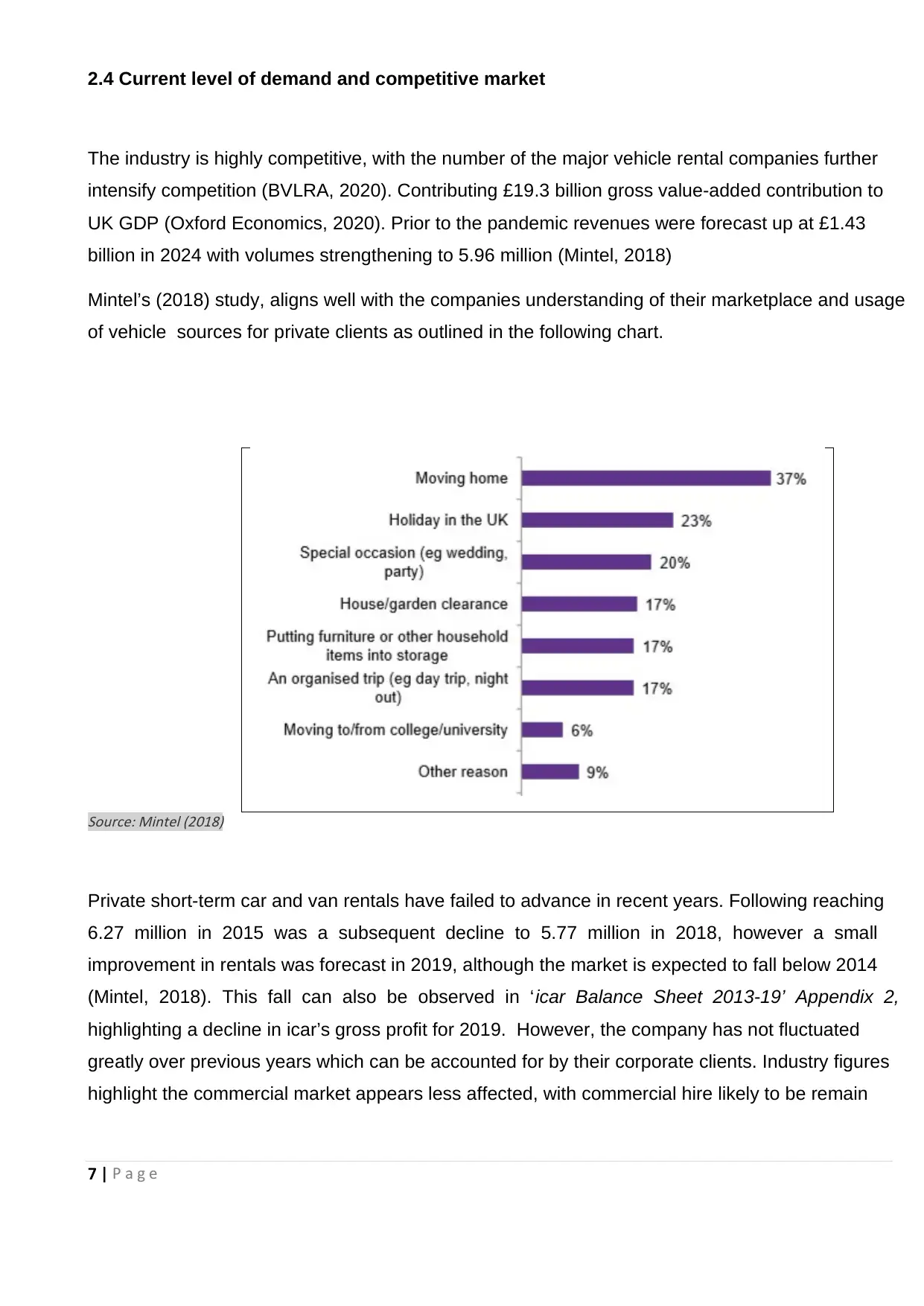
7 | P a g e
2.4 Current level of demand and competitive market
The industry is highly competitive, with the number of the major vehicle rental companies further
intensify competition (BVLRA, 2020). Contributing £19.3 billion gross value-added contribution to
UK GDP (Oxford Economics, 2020). Prior to the pandemic revenues were forecast up at £1.43
billion in 2024 with volumes strengthening to 5.96 million (Mintel, 2018)
Mintel’s (2018) study, aligns well with the companies understanding of their marketplace and usage
of vehicle sources for private clients as outlined in the following chart.
Source: Mintel (2018)
Private short-term car and van rentals have failed to advance in recent years. Following reaching
6.27 million in 2015 was a subsequent decline to 5.77 million in 2018, however a small
improvement in rentals was forecast in 2019, although the market is expected to fall below 2014
(Mintel, 2018). This fall can also be observed in ‘icar Balance Sheet 2013-19’ Appendix 2,
highlighting a decline in icar’s gross profit for 2019. However, the company has not fluctuated
greatly over previous years which can be accounted for by their corporate clients. Industry figures
highlight the commercial market appears less affected, with commercial hire likely to be remain
2.4 Current level of demand and competitive market
The industry is highly competitive, with the number of the major vehicle rental companies further
intensify competition (BVLRA, 2020). Contributing £19.3 billion gross value-added contribution to
UK GDP (Oxford Economics, 2020). Prior to the pandemic revenues were forecast up at £1.43
billion in 2024 with volumes strengthening to 5.96 million (Mintel, 2018)
Mintel’s (2018) study, aligns well with the companies understanding of their marketplace and usage
of vehicle sources for private clients as outlined in the following chart.
Source: Mintel (2018)
Private short-term car and van rentals have failed to advance in recent years. Following reaching
6.27 million in 2015 was a subsequent decline to 5.77 million in 2018, however a small
improvement in rentals was forecast in 2019, although the market is expected to fall below 2014
(Mintel, 2018). This fall can also be observed in ‘icar Balance Sheet 2013-19’ Appendix 2,
highlighting a decline in icar’s gross profit for 2019. However, the company has not fluctuated
greatly over previous years which can be accounted for by their corporate clients. Industry figures
highlight the commercial market appears less affected, with commercial hire likely to be remain
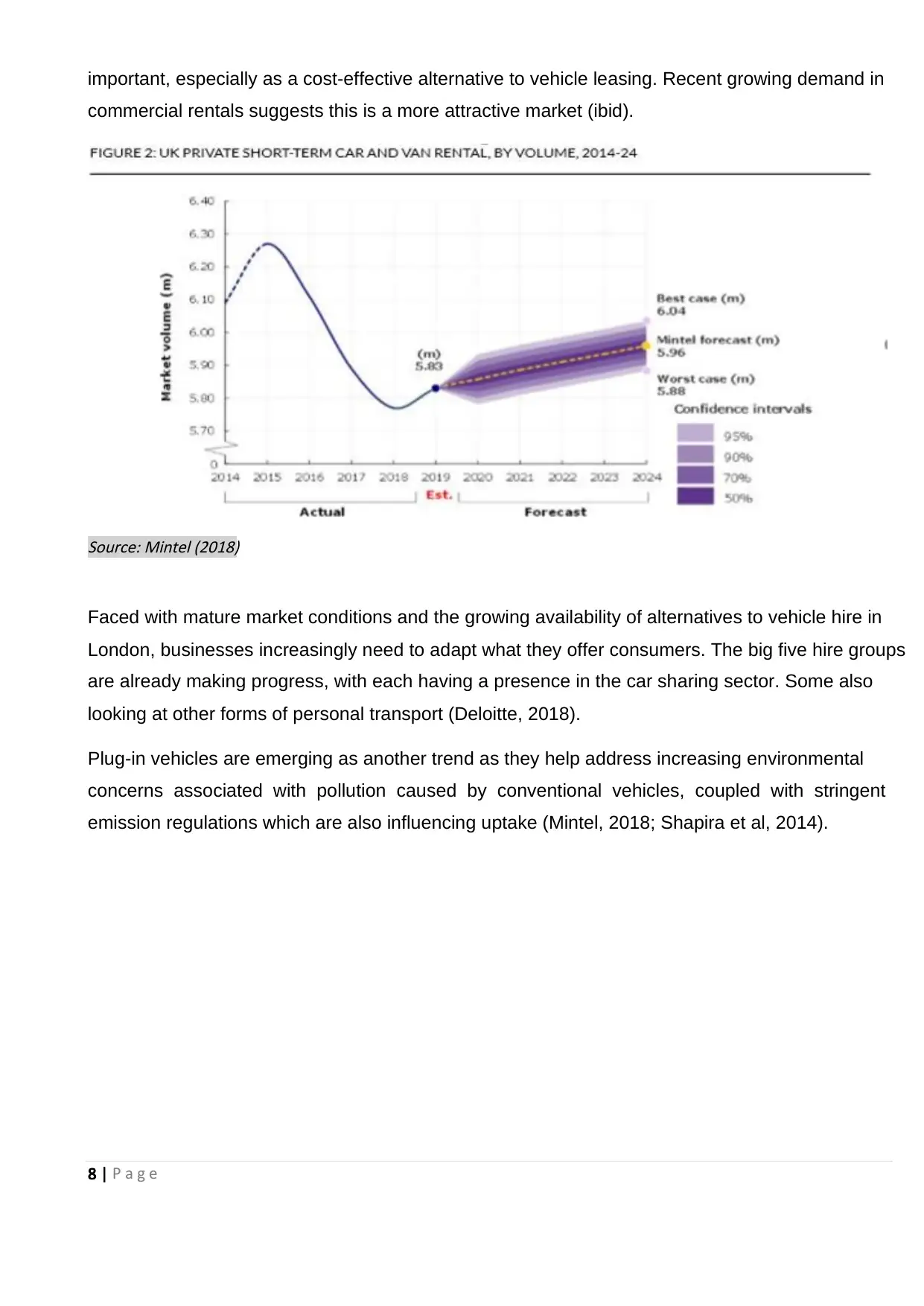
8 | P a g e
important, especially as a cost-effective alternative to vehicle leasing. Recent growing demand in
commercial rentals suggests this is a more attractive market (ibid).
Source: Mintel (2018)
Faced with mature market conditions and the growing availability of alternatives to vehicle hire in
London, businesses increasingly need to adapt what they offer consumers. The big five hire groups
are already making progress, with each having a presence in the car sharing sector. Some also
looking at other forms of personal transport (Deloitte, 2018).
Plug-in vehicles are emerging as another trend as they help address increasing environmental
concerns associated with pollution caused by conventional vehicles, coupled with stringent
emission regulations which are also influencing uptake (Mintel, 2018; Shapira et al, 2014).
important, especially as a cost-effective alternative to vehicle leasing. Recent growing demand in
commercial rentals suggests this is a more attractive market (ibid).
Source: Mintel (2018)
Faced with mature market conditions and the growing availability of alternatives to vehicle hire in
London, businesses increasingly need to adapt what they offer consumers. The big five hire groups
are already making progress, with each having a presence in the car sharing sector. Some also
looking at other forms of personal transport (Deloitte, 2018).
Plug-in vehicles are emerging as another trend as they help address increasing environmental
concerns associated with pollution caused by conventional vehicles, coupled with stringent
emission regulations which are also influencing uptake (Mintel, 2018; Shapira et al, 2014).
⊘ This is a preview!⊘
Do you want full access?
Subscribe today to unlock all pages.

Trusted by 1+ million students worldwide
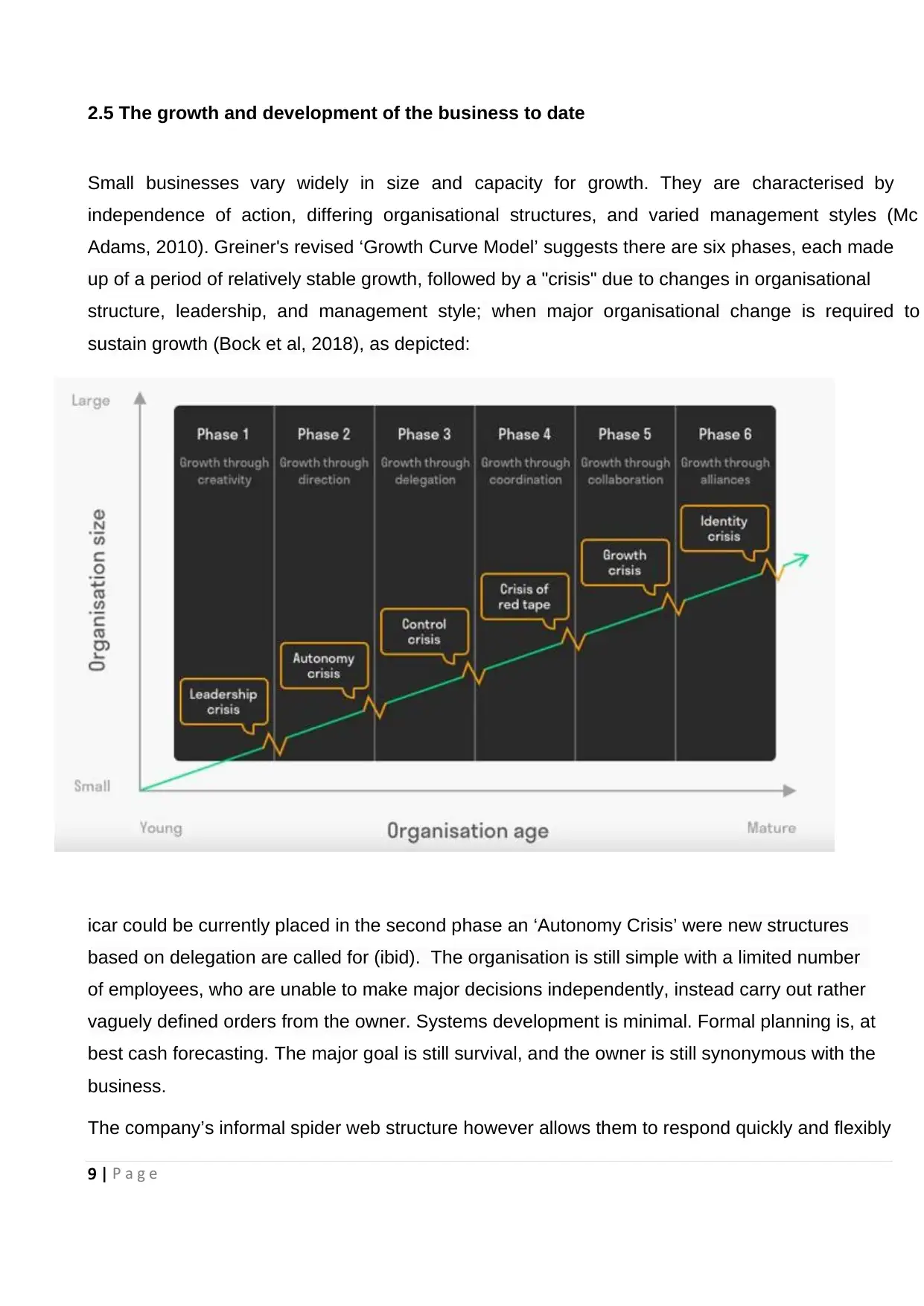
9 | P a g e
2.5 The growth and development of the business to date
Small businesses vary widely in size and capacity for growth. They are characterised by
independence of action, differing organisational structures, and varied management styles (Mc
Adams, 2010). Greiner's revised ‘Growth Curve Model’ suggests there are six phases, each made
up of a period of relatively stable growth, followed by a "crisis" due to changes in organisational
structure, leadership, and management style; when major organisational change is required to
sustain growth (Bock et al, 2018), as depicted:
icar could be currently placed in the second phase an ‘Autonomy Crisis’ were new structures
based on delegation are called for (ibid). The organisation is still simple with a limited number
of employees, who are unable to make major decisions independently, instead carry out rather
vaguely defined orders from the owner. Systems development is minimal. Formal planning is, at
best cash forecasting. The major goal is still survival, and the owner is still synonymous with the
business.
The company’s informal spider web structure however allows them to respond quickly and flexibly
2.5 The growth and development of the business to date
Small businesses vary widely in size and capacity for growth. They are characterised by
independence of action, differing organisational structures, and varied management styles (Mc
Adams, 2010). Greiner's revised ‘Growth Curve Model’ suggests there are six phases, each made
up of a period of relatively stable growth, followed by a "crisis" due to changes in organisational
structure, leadership, and management style; when major organisational change is required to
sustain growth (Bock et al, 2018), as depicted:
icar could be currently placed in the second phase an ‘Autonomy Crisis’ were new structures
based on delegation are called for (ibid). The organisation is still simple with a limited number
of employees, who are unable to make major decisions independently, instead carry out rather
vaguely defined orders from the owner. Systems development is minimal. Formal planning is, at
best cash forecasting. The major goal is still survival, and the owner is still synonymous with the
business.
The company’s informal spider web structure however allows them to respond quickly and flexibly
Paraphrase This Document
Need a fresh take? Get an instant paraphrase of this document with our AI Paraphraser
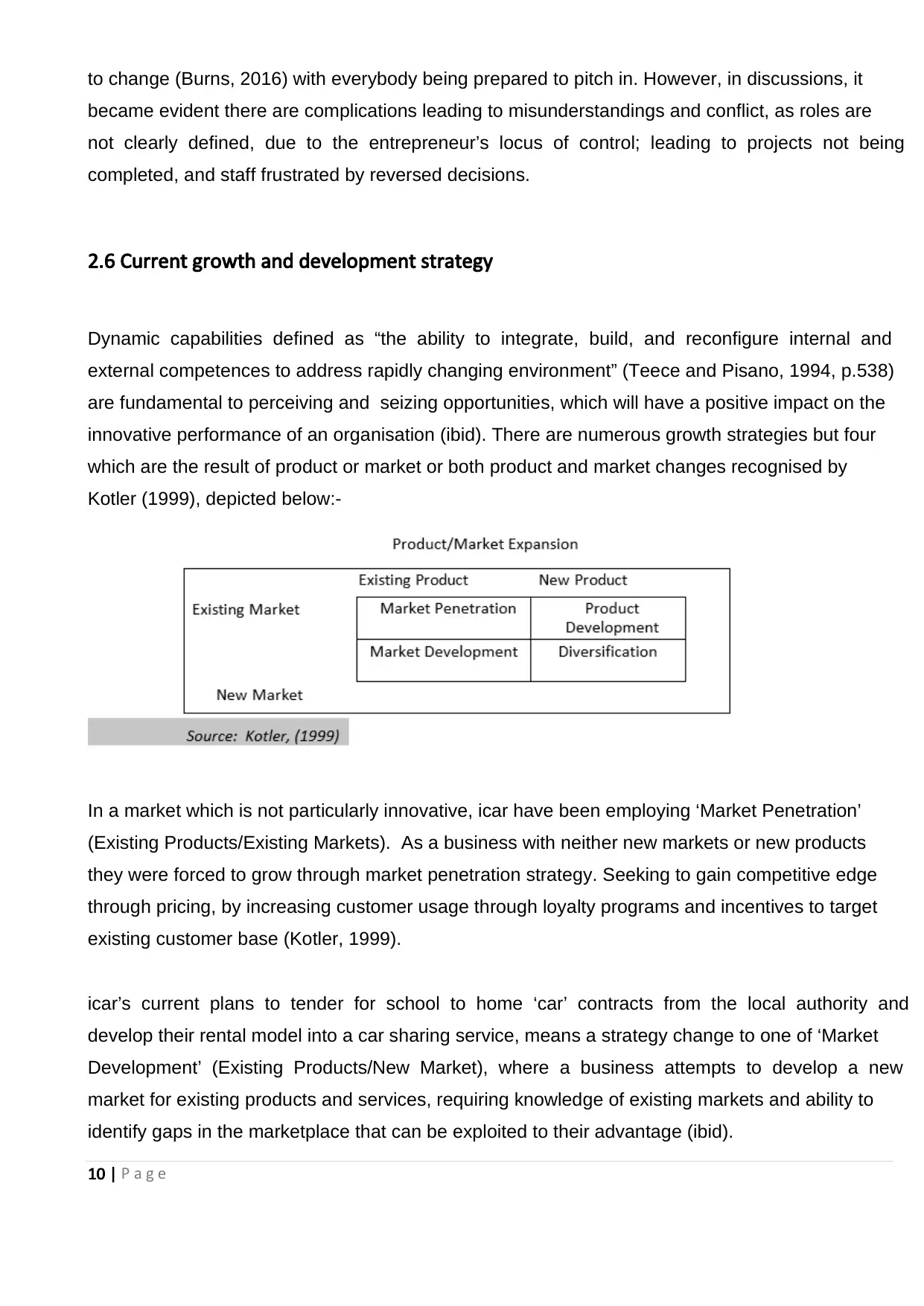
10 | P a g e
to change (Burns, 2016) with everybody being prepared to pitch in. However, in discussions, it
became evident there are complications leading to misunderstandings and conflict, as roles are
not clearly defined, due to the entrepreneur’s locus of control; leading to projects not being
completed, and staff frustrated by reversed decisions.
2.6 Current growth and development strategy
Dynamic capabilities defined as “the ability to integrate, build, and reconfigure internal and
external competences to address rapidly changing environment” (Teece and Pisano, 1994, p.538)
are fundamental to perceiving and seizing opportunities, which will have a positive impact on the
innovative performance of an organisation (ibid). There are numerous growth strategies but four
which are the result of product or market or both product and market changes recognised by
Kotler (1999), depicted below:-
In a market which is not particularly innovative, icar have been employing ‘Market Penetration’
(Existing Products/Existing Markets). As a business with neither new markets or new products
they were forced to grow through market penetration strategy. Seeking to gain competitive edge
through pricing, by increasing customer usage through loyalty programs and incentives to target
existing customer base (Kotler, 1999).
icar’s current plans to tender for school to home ‘car’ contracts from the local authority and
develop their rental model into a car sharing service, means a strategy change to one of ‘Market
Development’ (Existing Products/New Market), where a business attempts to develop a new
market for existing products and services, requiring knowledge of existing markets and ability to
identify gaps in the marketplace that can be exploited to their advantage (ibid).
to change (Burns, 2016) with everybody being prepared to pitch in. However, in discussions, it
became evident there are complications leading to misunderstandings and conflict, as roles are
not clearly defined, due to the entrepreneur’s locus of control; leading to projects not being
completed, and staff frustrated by reversed decisions.
2.6 Current growth and development strategy
Dynamic capabilities defined as “the ability to integrate, build, and reconfigure internal and
external competences to address rapidly changing environment” (Teece and Pisano, 1994, p.538)
are fundamental to perceiving and seizing opportunities, which will have a positive impact on the
innovative performance of an organisation (ibid). There are numerous growth strategies but four
which are the result of product or market or both product and market changes recognised by
Kotler (1999), depicted below:-
In a market which is not particularly innovative, icar have been employing ‘Market Penetration’
(Existing Products/Existing Markets). As a business with neither new markets or new products
they were forced to grow through market penetration strategy. Seeking to gain competitive edge
through pricing, by increasing customer usage through loyalty programs and incentives to target
existing customer base (Kotler, 1999).
icar’s current plans to tender for school to home ‘car’ contracts from the local authority and
develop their rental model into a car sharing service, means a strategy change to one of ‘Market
Development’ (Existing Products/New Market), where a business attempts to develop a new
market for existing products and services, requiring knowledge of existing markets and ability to
identify gaps in the marketplace that can be exploited to their advantage (ibid).
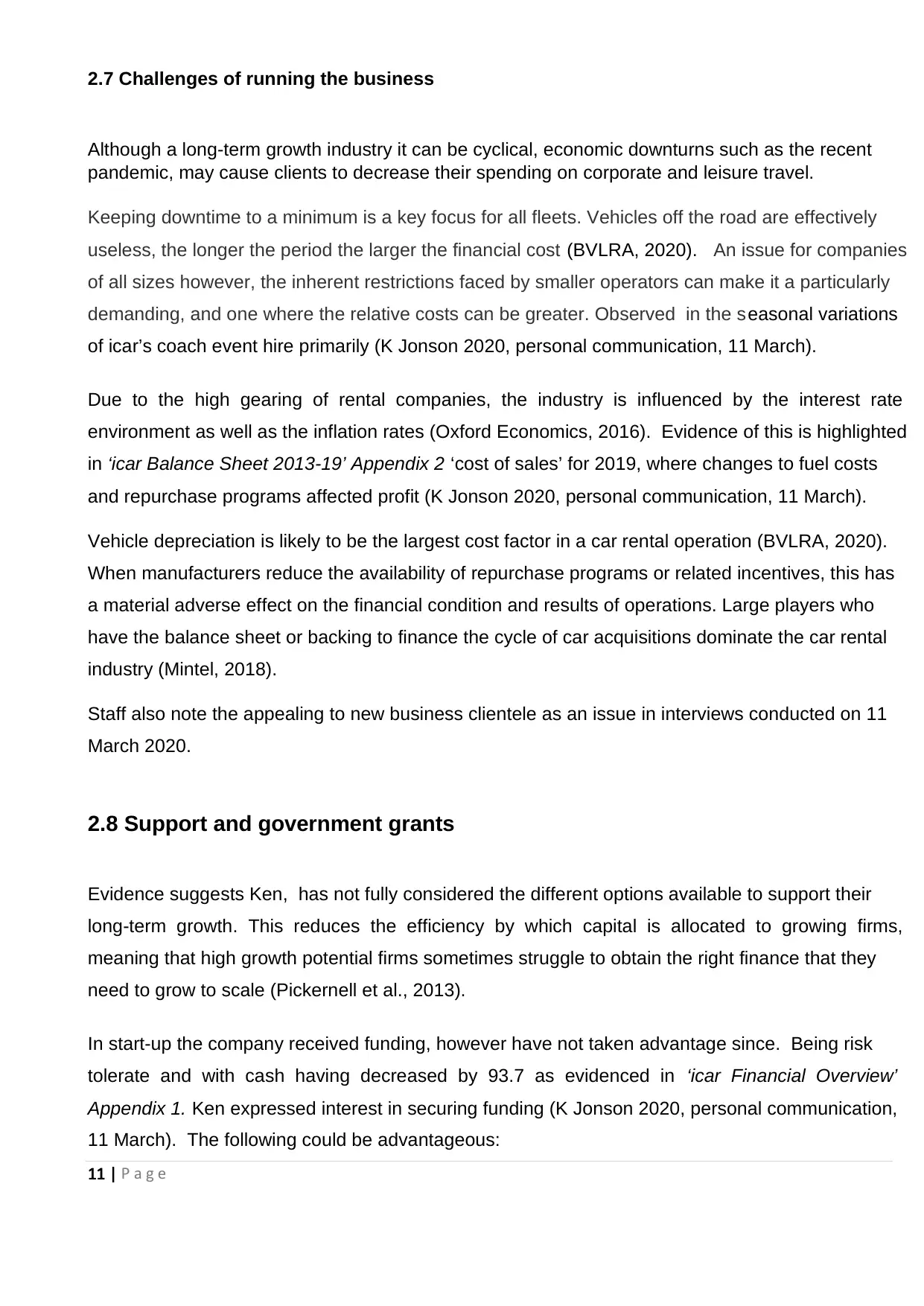
11 | P a g e
2.7 Challenges of running the business
Although a long-term growth industry it can be cyclical, economic downturns such as the recent
pandemic, may cause clients to decrease their spending on corporate and leisure travel.
Keeping downtime to a minimum is a key focus for all fleets. Vehicles off the road are effectively
useless, the longer the period the larger the financial cost (BVLRA, 2020). An issue for companies
of all sizes however, the inherent restrictions faced by smaller operators can make it a particularly
demanding, and one where the relative costs can be greater. Observed in the seasonal variations
of icar’s coach event hire primarily (K Jonson 2020, personal communication, 11 March).
Due to the high gearing of rental companies, the industry is influenced by the interest rate
environment as well as the inflation rates (Oxford Economics, 2016). Evidence of this is highlighted
in ‘icar Balance Sheet 2013-19’ Appendix 2 ‘cost of sales’ for 2019, where changes to fuel costs
and repurchase programs affected profit (K Jonson 2020, personal communication, 11 March).
Vehicle depreciation is likely to be the largest cost factor in a car rental operation (BVLRA, 2020).
When manufacturers reduce the availability of repurchase programs or related incentives, this has
a material adverse effect on the financial condition and results of operations. Large players who
have the balance sheet or backing to finance the cycle of car acquisitions dominate the car rental
industry (Mintel, 2018).
Staff also note the appealing to new business clientele as an issue in interviews conducted on 11
March 2020.
2.8 Support and government grants
Evidence suggests Ken, has not fully considered the different options available to support their
long-term growth. This reduces the efficiency by which capital is allocated to growing firms,
meaning that high growth potential firms sometimes struggle to obtain the right finance that they
need to grow to scale (Pickernell et al., 2013).
In start-up the company received funding, however have not taken advantage since. Being risk
tolerate and with cash having decreased by 93.7 as evidenced in ‘icar Financial Overview’
Appendix 1. Ken expressed interest in securing funding (K Jonson 2020, personal communication,
11 March). The following could be advantageous:
2.7 Challenges of running the business
Although a long-term growth industry it can be cyclical, economic downturns such as the recent
pandemic, may cause clients to decrease their spending on corporate and leisure travel.
Keeping downtime to a minimum is a key focus for all fleets. Vehicles off the road are effectively
useless, the longer the period the larger the financial cost (BVLRA, 2020). An issue for companies
of all sizes however, the inherent restrictions faced by smaller operators can make it a particularly
demanding, and one where the relative costs can be greater. Observed in the seasonal variations
of icar’s coach event hire primarily (K Jonson 2020, personal communication, 11 March).
Due to the high gearing of rental companies, the industry is influenced by the interest rate
environment as well as the inflation rates (Oxford Economics, 2016). Evidence of this is highlighted
in ‘icar Balance Sheet 2013-19’ Appendix 2 ‘cost of sales’ for 2019, where changes to fuel costs
and repurchase programs affected profit (K Jonson 2020, personal communication, 11 March).
Vehicle depreciation is likely to be the largest cost factor in a car rental operation (BVLRA, 2020).
When manufacturers reduce the availability of repurchase programs or related incentives, this has
a material adverse effect on the financial condition and results of operations. Large players who
have the balance sheet or backing to finance the cycle of car acquisitions dominate the car rental
industry (Mintel, 2018).
Staff also note the appealing to new business clientele as an issue in interviews conducted on 11
March 2020.
2.8 Support and government grants
Evidence suggests Ken, has not fully considered the different options available to support their
long-term growth. This reduces the efficiency by which capital is allocated to growing firms,
meaning that high growth potential firms sometimes struggle to obtain the right finance that they
need to grow to scale (Pickernell et al., 2013).
In start-up the company received funding, however have not taken advantage since. Being risk
tolerate and with cash having decreased by 93.7 as evidenced in ‘icar Financial Overview’
Appendix 1. Ken expressed interest in securing funding (K Jonson 2020, personal communication,
11 March). The following could be advantageous:
⊘ This is a preview!⊘
Do you want full access?
Subscribe today to unlock all pages.

Trusted by 1+ million students worldwide
1 out of 22
Related Documents
Your All-in-One AI-Powered Toolkit for Academic Success.
+13062052269
info@desklib.com
Available 24*7 on WhatsApp / Email
![[object Object]](/_next/static/media/star-bottom.7253800d.svg)
Unlock your academic potential
Copyright © 2020–2025 A2Z Services. All Rights Reserved. Developed and managed by ZUCOL.


